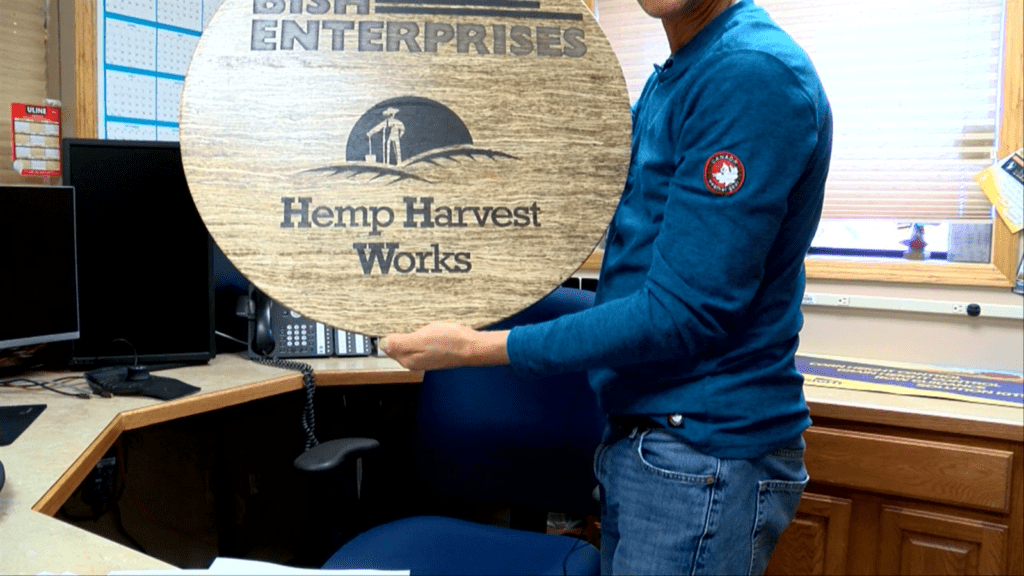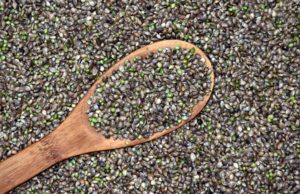
GILTNER, Neb. — Compared to many other states, Nebraska performed poorly when it comes to hemp production, and that’s according to the U.S Department of Agriculture (USDA) National Agricultural Statistics Service (NASS) 2021 Hemp Acreage and Production Survey.
The 2021 survey collected data for hemp grown in the open and hemp under protection.
Planted area for industrial hemp grown in the open for all utilizations in the United States totaled 54,152 acres. Of those acres, Nebraska planted only 260, and harvested 250 acres.
Hemp-derived products don’t contain enough THC to create the “high” traditionally associated with marijuana. Hemp is used to make a variety of commercial and industrial products, including rope, textiles, clothing, shoes, food, paper, bioplastics, insulation and biofuel.
Andrew Bish is the chief operating officer at Bish Enterprises, a family owned business in Giltner. They design and manufacture agriculture harvesting solutions. Bish is also the founder and CEO of Hemp Harvest Works.
“There’s not even hardly an [hemp] industry in the state of Nebraska,” Bish said. “We can’t get any worse I don’t think, unless we stop growing hemp entirely.”
Bish has sold multiple hemp cutting machines all over the country, machines they manufacture themselves. Bish said there has been some growth in the industry. He said he is optimistic about the 2023 season of grain and fiber sectors of hemp, but he said things need to improve in the state.
“There’s a lot of upward opportunity for Nebraska farmers, and Nebraska is one of the best territories to grow hemp so I see a lot of opportunity here, we just haven’t seen that yet,” Bish said.
For those opportunities to happen, he said Nebraska needs to align its hemp regulations with the federal guidelines. Due to the current state laws regarding hemp production, Bish produces hemp in Colorado. His hope this year is to grow 7,000 acres there.
“The regulations are easier there, the state is set-up to work with hemp producers in a much simpler way, they follow the national regulations,” Bish said. “There’s a bill in front of the Nebraska legislature that hopefully we can get passed this year.”
Bish was referring to LB 263, which is set to change and update federal references of hemp; to define the term; to eliminate obsolete provisions; to change provisions relating to the state plan for regulation of hemp, fees, duties, violations, testing and transporting of hemp; to provide for remediation of certain hemp; to change a meeting requirement for the Nebraska Hemp Commission; to harmonize provisions; and to repeal the original sections. Click here to learn more about LB 263.
Many say the bill, which would align more with federal regulations, could attract more hemp producers and investors to the state.
“Particularly clarifying the negligence rule, as well as the harvest rule, I think it will help address some uncertainty and difficulties for producers. These clarifications will remove some obstacles for investing and processing,” said Richard Leonard, research analyst at the Nebraska Legislature – Agriculture Committee.
Leonard said that in Nebraska the previous harvest window required that hemp be harvested within 15 days from the day the official sample is taken to determine the tetrahydrocannabinol (THC) content, the new rule would expand that to 30 days.
Currently any hemp that is above 1% of THC has to be destroyed. That’s not changing, but any producers with hemp above 0.5% THC will receive a negligence violation, which would result in the producer and the Department of Agriculture working together to make sure future hemps stay at 0.3% or less THC. An additional change of LB 263 would also incorporate alternatives for hemp disposal.
NASS estimated the total value of hemp production nationally was at $824 million in 2021. This year’s Hemp Production and Disposition Inquiry survey will collect information on the total planted and harvested area, yield, production and value of hemp in the United States.
Survey recipients are asked to respond securely online, by mail or fax. Those who do not respond by Jan. 30 may be contacted to arrange an interview to complete the survey.
“It [the survey] really helps the farmer understand the hemp market they are working in,” Bish said. “It also helps investors to be more guided in order to invest in this industry.”
Bish said he is hopeful about the future of hemp.
“The larger market place for hemp is going to be in the stalk and in the seed, and those are going to be building materials, insulative materials, clothing materials, when you look at grain the opportunity to feed animals is huge, we already have a feed shortage in the country and hemp can help with that.”



